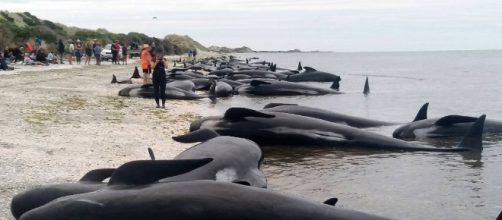The sound of faint cries caused Cheree Morrison to investigate the shores of Farewell Spit, New Zealand on Friday, February 10. What she saw was more than 400 pilot whales washed ashore, more than 275 of them were already dead. Within a few hours, a massive rescue effort was launched gathering people from all sides of the local community from students to tourists to farmers. What caused this carnage and how successful was the rescue effort?
Not the first mass stranding on Farewell Spit
This particular sliver of sand arches like a hook into the Tasman Sea.
It often confuses whales and has been the site of previous mass strandings, earning it the nickname "the whale trap." Beached whales appear most years here, but without a doubt Friday displayed one of the worst carnage episodes in the nation's history. Only two previous events topped the 400 stranded this year in 1918 when 1,000 pilot whales were stranded and in 1985 with 450.
Several theories exist as to why whales become stranded, including chasing prey too far in shore to protecting a sick member of their community. The gently sloping beaches of Farewell Spit make it very difficult for whales to navigate away when they swim too close. The cause of this particular incident remains a mystery and is chalked up to unfortunate geography.
Project Jonah
Authorities were asking for nearby, able-bodied volunteers to join in the rescue effort. Those who appeared were a diverse bunch of students, farmers, and even tourists. Cold buckets of water relieved the few whales that were still alive and volunteers maneuvered the whales upright so they could breath more easily.
As the tide came in, volunteers were able to refloat several of the surviving whales. They proceeded to make a human chain in the water to stop the creatures from becoming stranded a second time. It will take a few days to determine just how successful their efforts were, but 100 or so were likely saved out of 416, the Department of Conversation put the dead whales at about 250 to 300.

